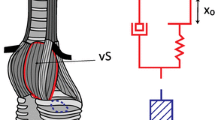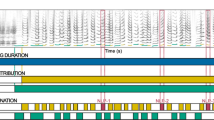Abstract
Bird song is a complex behavior that requires the coordination of several motor systems. Sound is produced in the syrinx and then modified by the upper vocal tract. Movements of the hyoid skeleton have been shown in the northern cardinal (Cardinalis cardinalis) to be extensively involved in forming an oropharyngeal–esophageal cavity (OEC), which contributes a major resonance to the vocal tract transfer function. Here we report that a similar relationship exists between the volume of the OEC and the fundamental frequency in the white-throated sparrow (Zonotrichia albicollis) whose song, unlike that of the cardinal, consists of a series of almost constant frequency notes. Cineradiography of singing sparrows shows that the oropharyngeal cavity and cranial end of the esophagus expand abruptly at the start of each note and maintain a relatively constant volume until the end of the note. Computation of the vocal tract transfer function suggests a major resonance of the OEC follows the fundamental frequency, making sound transmission more efficient. The presence of similar prominent song-related vocal tract motor patterns in two Oscine families suggests that the active control of the vocal tract resonance by varying the volume of the OEC may be widespread in songbirds.







Similar content being viewed by others
Abbreviations
- f 0 :
-
Fundamental frequency
- LH:
-
Distance between larynx and beak–skull transition
- LV:
-
Distance between the larynx and second vertebra
- OEC:
-
Oropharyngeal–esophageal cavity
- WTS:
-
White-throated sparrow
References
Beckers GJL, Suthers RA, ten Cate C (2003) Pure-tone birdsong by resonance filtering of harmonic overtones. Proc Natl Acad Sci USA 100:7372–7376
Borror DJ, Gunn WWH (1965) Variation in white-throated sparrow songs. Auk 82:26–47
Brainerd EL, Owerkowicz T (2006) Functional morphology and evolution of aspiration breathing in tetrapods. Respir Physiol Neurobiol 154:73–88
Daley M, Goller F (2004) Tracheal length changes during zebra finch song and their possible role in upper vocal tract filtering. J Neurobiol 59:319–330
Elemans CPH, Laje R, Mindlin GB, Goller F (2007) Coupling and source-filter interaction in birdsong. In: Eighth international congress of neuroethology. University of British Columbia, Vancouver, p 97
Falls JB, Kopachena JG (1994) White-throated sparrow (Zonotrichia albicollis). In: Poole A (ed) Birds of North America online. Cornell Laboratory of Ornithology, Ithaca. Retrieved from the Birds of North America online: http://bna.birds.cornell.edu/bna/species/128
Fant G (1960) Acoustic theory of speech production. Mouton, The Hague
Fletcher NH, Tarnopolsky A (1999) Acoustics of the avian vocal tract. J Acoust Soc Am 105:35–49
Fletcher NH, Riede T, Suthers RA (2006) Model for vocalization by a bird with distensible vocal cavity and open beak. J Acoust Soc Am 119:1005–1011
Font E, Rome LC (1990) Functional morphology of dewlap extension in the lizard (Anolis equestris; Iguanidae). J Morphol 206:245–258
Galis F (1996) The application of functional morphology to evolutionary studies. Trends Ecol Evol 11:124–129
Goller F, Larsen ON (1997) A new mechanism of sound generation in songbirds. Proc Natl Acad Sci USA 94:14787–14791
Goller F, Mallinckrodt MJ, Torti SD (2004) Beak gape dynamics during song in the zebra finch. J Neurobiol 59:289–303
Hoese WJ, Podos J, Boetticher NC, Nowicki S (2000) Vocal tract function in birdsong production: experimental manipulation of beak movements. J Exp Biol 203:1845–1855
Hurly TA, Ratcliffe L, Weisman R (1990) Relative pitch recognition in white-throated sparrows, Zonotrichia albicollis. Anim Behav 40:176–181
Hurly TA, Weisman RG, Ratcliffe L, Johnsrude IS (1991) Absolute and relative pitch production in the song of the white-throated sparrow Zonotrichia albicollis. Bioacoustics 3:81–92
Kuhl PK, Rivera-Gaxiola M (2008) Neural substrates of early language acquisition. Annu Rev Neurosci 31:511–534
Kuhl PK, Conboy BT, Padden D, Nelson T, Pruitt J (2005) Early speech perception and later language development: implications for the critical period. Lang Learn Dev 1:237–264
Larsen ON, Goller F (1999) Role of syringeal vibrations in bird vocalizations. Proc R Soc Lond B Biol Sci 266:1609–1615
Martins EP (2001) Tracker program for frame by frame analysis of video clips. Department of Biology, Indiana University, Bloomington. Distributed by the author at http://www.indiana.edu/~martinsl/tracker.html
Moriyama K, Okanoya K (1996) Effect of beak movement in singing Bengalese finches. In: Abstracts of the third joint meeting, Acoustical Society of America and Acoustical Society of Japan, Honolulu, 2–6 December 1996, pp 129–130
Nelson BS, Beckers GJL, Suthers RA (2005) Vocal tract filtering and sound radiation in a songbird. J Exp Biol 208:297–308
Nowicki S (1987) Vocal tract resonances in oscine bird sound production: evidence from birdsongs in a helium atmosphere. Nature 325:53–55
Owerkowicz T, Farmer CG, Hicks JW, Brainerd EL (1999) Contribution of gular pumping to lung ventilation in monitor lizards. Science 284:1661–1663
Podos J, Southall JA, Rossi-Santos MR (2004) Vocal mechanics in Darwin’s finches: correlation of beak gape and song frequency. J Exp Biol 207:607–619
Riede T, Beckers GJL, Blevins W, Suthers RA (2004) Inflation of the esophagus and vocal tract filtering in ring doves. J Exp Biol 207:4025–4036
Riede T, Suthers RA, Fletcher NH, Blevins W (2006) Songbirds tune their vocal tract to the fundamental frequency of their song. Proc Natl Acad Sci USA 103:5543–5548
Suthers RA, Goller F (1997) Motor correlates of vocal diversity in songbirds. In: Nolan V Jr, Ketterson E, Thompson CF (eds) Current ornithology. Plenum Press, New York, pp 235–288
Suthers RA, Zollinger SA (2008) From brain to song: the vocal organ and vocal tract. In: Zeigler P, Marler P (eds) The neuroscience of birdsong. Cambridge University Press, Cambridge (in press)
Weary DM, Weisman RG (1992) Temporal relationships in white-throated sparrow song. Condor 94:1013–1016
Westneat MW, Long J, John H, Hoese W, Nowicki S (1993) Kinematics of birdsong: functional correlation of cranial movements and acoustic features in sparrows. J Exp Biol 182:147–171
Wild JM (1997) Neural pathways for the control of birdsong production. J Neurobiol 33:653–670
Acknowledgments
We thank Dr. Donna Maney for providing the birds used in this experiment and Amy Coy for assistance in preparation of the figures. Supported by NIH-NINDS R01 NS029467 to R.A. Suthers and by a Postdoctoral fellowship from the ‘Deutsche Akademie der Naturforscher Leopoldina’ (BMBF-LPD 9901/8-127) to T. Riede. We thank Chauncey Frend and Jeff Rogers (Advanced Visualization Lab, Indiana University, Bloomington) for three-dimensional modeling and the video animation. The experiments reported in this paper were reviewed and approved by the Institutional Animal Care and Use Committee and the Radiation Safety Office of Indiana University, and comply with the ‘Principles of animal care’, publication no. 86-23, revised 1985 of the National Institute of Health.
Author information
Authors and Affiliations
Corresponding author
Electronic supplementary material
Below is the link to the electronic supplementary material.
This movie shows the X-ray images of lateral views of a white-throated sparrow spontaneously singing one complete song. The shape of the oropharyngeal-esophageal cavity (OEC) is indicated by superimposing a 3D polygonal model of the cavity. The song is first played at normal speed and then repeated in slow motion. During the third repetition the image of the head and neck at normal speed is enlarged and rotated (MOV 27 mb)
Rights and permissions
About this article
Cite this article
Riede, T., Suthers, R.A. Vocal tract motor patterns and resonance during constant frequency song: the white-throated sparrow. J Comp Physiol A 195, 183–192 (2009). https://doi.org/10.1007/s00359-008-0397-0
Received:
Revised:
Accepted:
Published:
Issue Date:
DOI: https://doi.org/10.1007/s00359-008-0397-0




